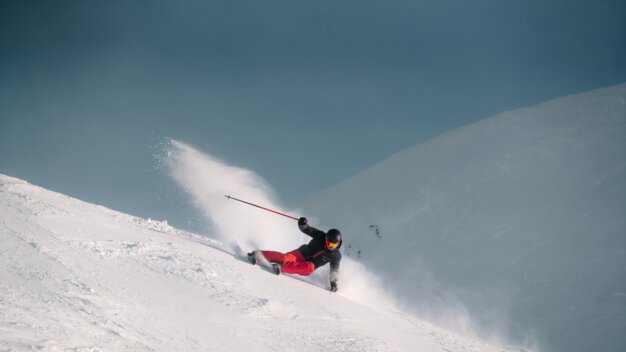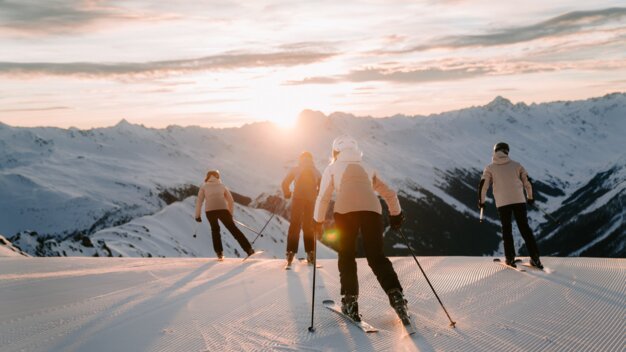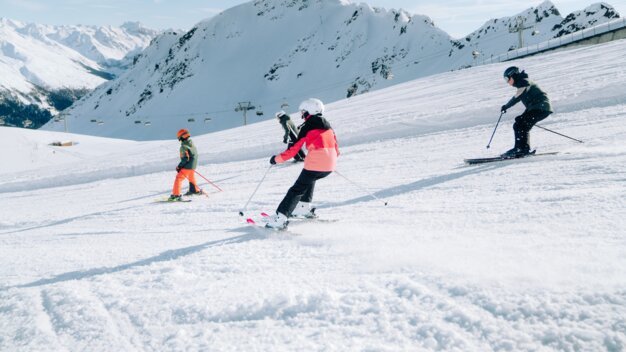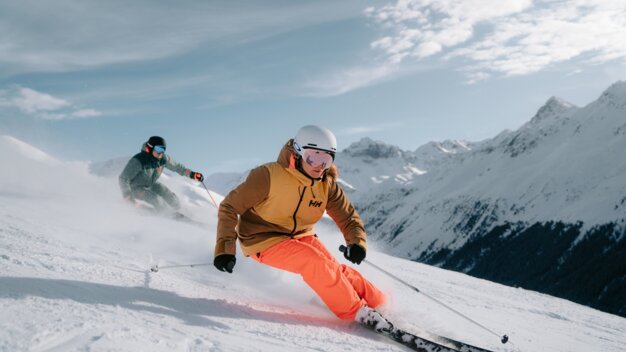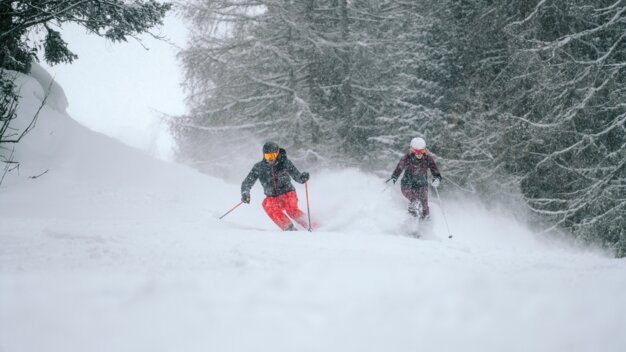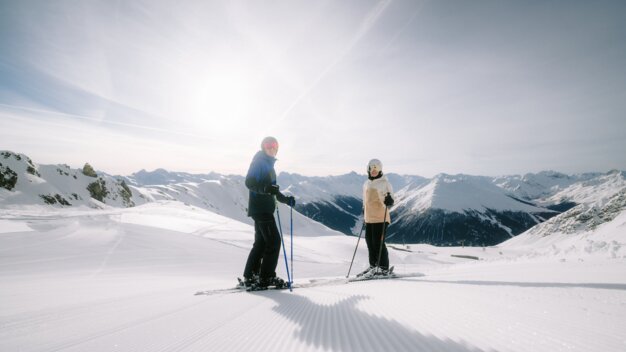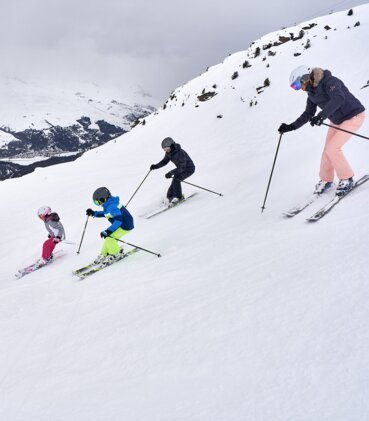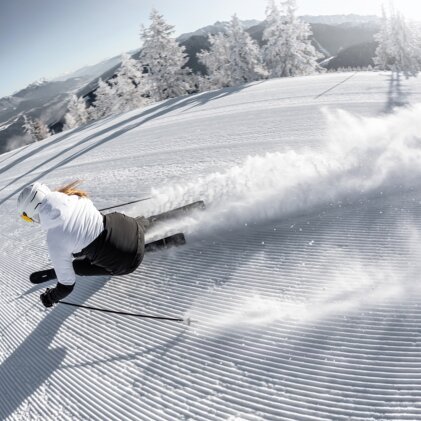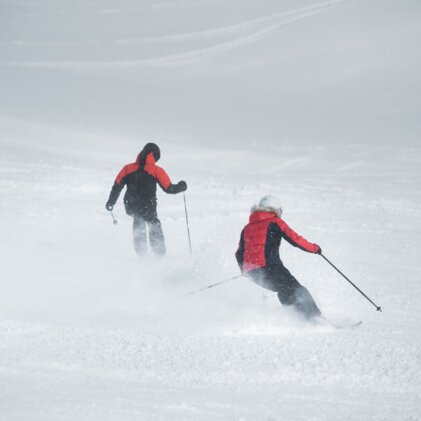
Everyone who has ever been skiing or snowboarding is familiar with blue, red and black slopes. But what exactly do these colours on ski slopes mean? The colour coding not only gives you an indication of the gradient, but also provides orientation and safety. Ski slope markings help you to assess the level of difficulty of the descent in the ski area and support harmonious interaction.
But what do black diamonds, green circles or yellow slope markings mean? And are the markings actually the same in every country? In this article, we explain everything you need to know about slope markings to be safe and informed on the mountain!
Why are there ski slope difficulty charts?
First and foremost, the colours are recommendations and offer winter sports enthusiasts a voluntary guide as to which slopes in the ski area are suitable for your ability. At the same time, they contribute to general safety by helping to prevent accidents caused by misjudgements and promote responsible skiing.
Depending on ability, the day's condition and the current snow and weather conditions , everyone has to decide for themselves when skiing and snowboarding: Do I trust myself on this slope or would I rather try a different, easier run? Can I ski the slope safely, or am I putting myself and others at risk due to my inadequate skiing technique? Plasters and crutches are not among the ski fashion trends this season either.
Whether you are a beginner, advanced or professional skier, everyone should take their own judgement and the current conditions into account when choosing ski resorts. The following factors can play a role here:
The following factors can influence your decision:
- Getting tired and worn out
- Weather conditions: Windrain, snowfall or fog
- Slope conditions: Ice, moguls or unprepared terrain
- Visibility conditions: Especially in fog or strong sunlight
The more comfortable you are with your own skiing ability, the safer and more enjoyable your day in the ski resort will be. To conquer the slopes perfectly equipped, hire your equipment at one of our INTERSPORT Rent locations - expert advice included.
How are the colours for the ski slope levels determined?
The colour of the level markings is determined according to the motto: The steeper, the more difficult. At least that is the case in most countries in the Alps. To do this, the average gradient of the terrain on the respective section of the slope is determined using special measuring equipment:
- Blue slopes: Maximum gradient of 25%
- Red slopes: 25 to 40 % gradient
- Black slopes: over 40 % gradient
Good to know: The colours are only guidelines and cannot cover all conditions. A blue piste can quickly turn from an easy slope to a difficult one when it is icy. Weather conditions must therefore always be considered when skiing or snowboarding. Permanent structural changes in ski areas, such as the widening or creation of bends, can, however, be a reason to change the colour marking.
Difficulty levels of ski slopes: orientation and more safety for skiers
The colour of the slope markings is determined by the gradient and not the difficulty. Anyone who skis in the Alps should be able to quickly find their way around any ski area using the standard markings.
Good to know: Colour-coded slopes are regularly (at least daily) checked, groomed and secured against avalanches.
These are the slope levels you should know
The coloured markings on ski slopes therefore inform you about the difficulty level of a descent and help you to make the right choice for your ability, your ski equipment and the current conditions. Whether you are a beginner, intermediate or advanced skier - the colours of the slopes are your guide to a successful day's skiing.
To ensure that you are always safe on the slopes, you will find the most important level markings for your perfect day of skiing below:
Blue slopes – easy
Blue slopes are ideal for beginners, children and those returning to skiing. With a maximum gradient of 25 per cent, they are ideal for learning and practising basic technical skills. In addition, blue slopes are usually relatively wide . Exceptions are short sections in open terrain.
Red slopes – medium difficulty
The average gradient of a red slope is between 25 and 40 per cent. They are generally somewhat narrower than blue ones and are ideal for advanced skiers and snowboarders. Many winter sports enthusiasts use ski resorts with red slopes to prepare for steeper descents or to carve extensively. But even short turns on medium-difficulty slopes are a pleasure.
Black slopes – difficult
All ski slopes with a gradient of more than 40 per cent are marked black and are only suitable for experienced skiers. Skiing on black slopes is dangerous for beginners. Precise technique, quick reactions and fitness are required here. Those who are practised in short turns and fast skiing will definitely have fun there. However, carving is not advisable on steep descents. Beginners should only approach these slopes once they have mastered red runs.
Further ski slope levels
In addition to the classic colours blue, red and black, which ski resorts use to mark the difficulty level of regular slopes, there are additional markings that are used for special routes or unsecured areas. These markings are particularly important for experienced skiers who are looking for new challenges, want to venture off the groomed slopes or are travelling to countries such as France, North America or Scandinavia.
Green:
- in many places very easy, flat or practice slopes (without precise definition)
- ideal for beginners or children
- rather rare in the Alps
- in France and North America: slopes with a gradient of between 6 and 25%
- in Scandinavia and Spain: Practice slopes with a gradient of up to 16 per cent
Yellow, orange or red dashed:
- Ski routes: Marked and secured, but not groomed
- require experience, technical skills and a safe driving style
- are usually checked irregularly, but are nevertheless in the secured ski room
- Exception: In France, ski routes officially count as controlled areas.
Free ski area (freeride areas):
Everything outside the marked ski slopes is considered free ski area - also known as off-piste. These areas are not controlled or secured and harbour an increased risk of avalanches or other dangers. They should therefore only be used by experienced skiers and snowboarders with the appropriate equipment and knowledge.
Difficulty of ski slopes abroad
Other countries, other markings. This may not apply to the Alps, but there are a few examples elsewhere. We have summarised these for you below (percentages = gradient).
Sweden and Norway
- green: up to 16 %
- blue: up to 27 %
- red: up to 47 %
- black: more than 47 %
- double black: extremely difficult
North America
- green circle: 6 to 25 %
- blue square: 25 to 40 %
- black diamond: more than 40 per cent
- double black diamond: extremely difficult, e.g. with tight bends and unclear edges
Note: The coloured slope markings in the North American system only ever relate to each other within a ski area. This means that a green circle can mean different levels of difficulty in different ski resorts.
What to do if the slope is too challenging?
It has happened to most skiers: Suddenly you find yourself in front of or on a slope and can't get any further. Too steep, too icy, too bumpy. Panic. No more strength. Poor visibility. In situations like this: keep calm:
- Turn round: Ride carefully back to the lift if possible.
- Sliding technique: At the edge of the slope, you can slide down slowly and in a controlled manner until you find an easier turn-off.
- Take a break: If visibility is poor or you are exhausted, you can retreat to the nearest hut.
Ski slope levels: Tips for beginners and maximum safety
For a successful day of skiing, it is not only important to have the right equipment, but also good preparation and safe behaviour on the slopes. For beginners in particular, it is advisable to practise on easy slopes first and gradually improve. Both the choice of the right slopes and the current weather conditions play a decisive role here. With the following tips, you are ideally equipped to glide safely and enjoyably through the snow.
- Choose suitable slopes: Start with blue slopes to gain confidence.
- Pay attention to the weather conditions: Ice, fog or strong winds can make any piste more challenging.
- Equip yourself properly: Good ski goggles, a helmet and suitable ski boots contribute to your safety.
- Observe the FIS rules: Ride in a controlled manner, keep sufficient distance from others and pay attention to markings and signs.
With this information, you are well prepared for your next day of skiing. Whether you're a beginner or a pro, the right choice of slopes makes a significant contribution to your skiing fun and safety. Visit an INTERSPORT Rent shop near you and get advice on your ski equipment!
Frequently asked questions about ski slope difficulty charts
What do the colours on slopes mean?
The colours blue, red and black indicate the level of difficulty of a slope. Blue stands for easy, red for medium and black for difficult. Green is often used for practice slopes, and yellow or dashed markings indicate unprepared ski routes.
Which slopes are for beginners?
Blue slopes are particularly suitable for beginners, as they have a gentle gradient of no more than 25 % and offer wide, easy descents. These are ideal for practising basic skiing techniques such as braking, steering and cornering. In some ski resorts, there are also green-marked descents that are even flatter and specially designed for absolute beginners or children. Make sure you choose slopes with well-groomed conditions to make learning easier.
What is considered a steep ski slope?
A ski slope is considered steep if the gradient is over 40 %. Such slopes are usually marked in black and are intended for experienced skiers who are familiar with short turns and controlled skiing techniques. Particularly steep slopes can be even more challenging due to their width, surface conditions (such as moguls or ice) or narrow hairpin bends. For beginners and less experienced skiers, it is advisable to avoid them in order to avoid injury.
Are ski slope levels the same in every country?
No, slope markings vary depending on the country. While the Alpine region has similar standards, there are differences in the colours and their meaning in North America and Scandinavia, for example.
What warning signs are there on the ski slopes?
Blue, red and black markings indicate the difficulty of the terrain. However, there are other warning signs on ski slopes that provide important safety information. Here are the most common ones:
- Caution sign: A yellow triangle with an exclamation mark indicates danger spots such as narrow passages, junctions or difficult sections.
- Avalanche warning: A red sign with a stylised snow slab warns of avalanche danger. These areas should be avoided at all costs.
- Closed signs: Red signs with a crossed-out skier or snowboarder indicate closed slopes or areas that may not be skied on.
- Ski route signs: Yellow or orange markings indicate unprepared but secured ski routes.
- Signs for freeride zones: They warn you that you are outside the secured ski area and that additional precautions such as an avalanche transceiver are required.
Make sure you take all warning signs seriously so as not to endanger yourself and other winter sports enthusiasts.
INTERSPORT Rent tip
According to the general rules of behaviour of the international ski association FIS , every skier and snowboarder must ...
- ... observe the ski slope difficulty chart (blue, red, black), closures and general signalling.
- ... refrain from riding off-piste, in forest areas and protected areas.
- ... drive on sight.
- ... adapt his speed and driving style to his ability and to the terrain, snow and weather conditions as well as the traffic density.
Particular caution is required in this regard in fog and snowfall - and not just because of the reduced visibility. Fresh snow, for example, requires increased effort when skiing and can otherwise lead to mogul formation when skiing on flat slopes.
Even in windy and cold conditions, the body needs more energy to keep warm than at higher temperatures. A factor that should not be underestimated! Last but not least, remember: The conditions on a slope can change drastically over the course of the day. So reassess the situation on every descent!
PS: You can hire the right equipment for all weather and snow conditions from INTERSPORT Rent. Find a shop a shop in your holiday resort!
Related articles
You may also be interested in:

